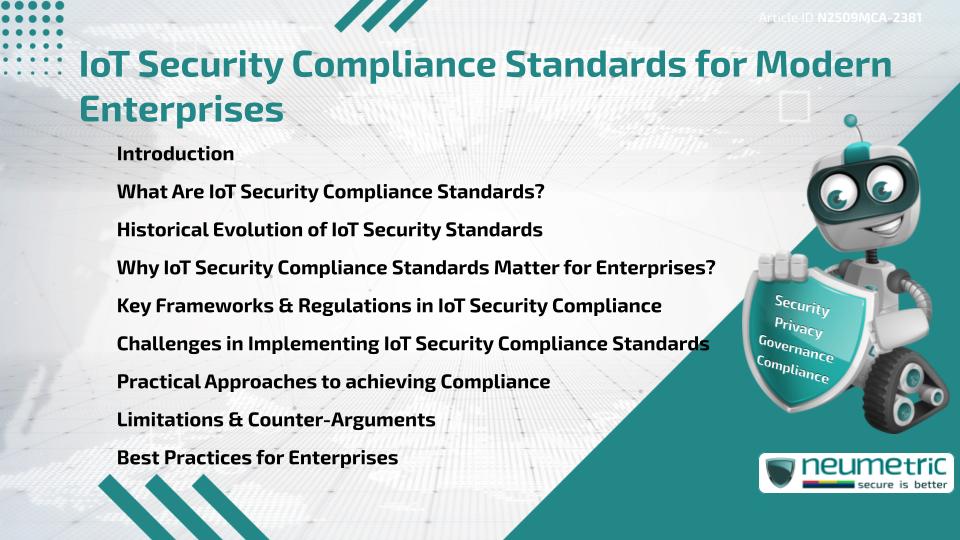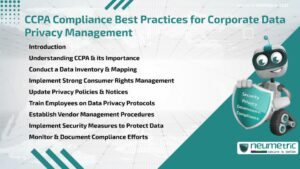Table of Contents
ToggleIntroduction
IoT security compliance standards are essential for protecting sensitive enterprise data, ensuring operational reliability & meeting legal requirements. With billions of interconnected devices collecting & transmitting data, enterprises must adhere to these standards to prevent Cyber Threats, reduce legal Risks & maintain Customer Trust. These standards provide structured guidelines that help enterprises manage Security Controls, address Vulnerabilities & establish accountability across devices & networks.
What Are IoT Security Compliance Standards?
IoT security compliance standards are structured guidelines & regulatory frameworks that govern how Organisations should secure their Internet of Things [IoT] ecosystems. These standards define requirements for Data Encryption, Access Control, device authentication & regular Risk Assessments. They serve as benchmarks that enterprises must meet to ensure their IoT deployments remain safe from evolving Cyber Threats.
Historical Evolution of IoT Security Standards
The first wave of IoT devices lacked formal security protocols, often leading to breaches & widespread Vulnerabilities. As incidents increased, Organisations like the National Institute of Standards & Technology [NIST] and the International organisation for Standardization [ISO] began developing security standards. Over time, these frameworks evolved to address not only technical safeguards but also compliance obligations, aligning with broader regulations like the General Data Protection Regulation [GDPR].
Why IoT Security Compliance Standards Matter for Enterprises?
Enterprises rely on IoT devices for operations, logistics & Customer engagement. Without compliance, these devices can become gateways for attackers. Non-compliance also carries legal & Financial consequences, including fines & reputational damage. Beyond Risk Management, adopting IoT security compliance standards boosts consumer confidence, as clients are more likely to trust businesses that demonstrate strong security Governance.
Key Frameworks & Regulations in IoT Security Compliance
Several key frameworks guide IoT security compliance:
- NIST Cybersecurity Framework – provides guidelines on Risk identification & mitigation.
- ISO/IEC 27001 – establishes an Information Security Management System [ISMS].
- GDPR – regulates how Personal Data is collected, stored & processed.
- California IoT Security Law – requires unique preprogrammed passwords & security features in connected devices.
- IEC 62443 – addresses industrial automation & control systems security.
Each Framework addresses different aspects, yet collectively they form a foundation for enterprises to secure their IoT ecosystems.
Challenges in Implementing IoT Security Compliance Standards
Enterprises often face challenges such as:
- Device diversity: IoT devices come from different manufacturers with varying security capabilities.
- Scalability: Managing compliance across thousands of devices can overwhelm IT teams.
- Resource limitations: Smaller Organisations may lack budgets for advanced compliance tools.
- Regulatory complexity: Overlapping & sometimes conflicting regulations create confusion.
Practical Approaches to achieving Compliance
Enterprises can adopt several strategies to align with IoT security compliance standards:
- Conduct regular Risk Assessments & audits.
- Implement device identity management solutions.
- Use strong encryption for data in transit & at rest.
- Train Employees on IoT-specific security protocols.
- Partner with vendors who comply with recognized security frameworks.
Limitations & Counter-Arguments
Critics argue that IoT security compliance standards may not keep pace with rapidly evolving Threats. Compliance does not always equal security, as attackers may exploit unknown Vulnerabilities. Additionally, strict regulations can slow down innovation & create Financial burdens, especially for startups & Small Businesses.
Best Practices for Enterprises
To successfully navigate IoT security compliance standards, enterprises should:
- Adopt a layered security approach combining compliance with proactive monitoring.
- Engage Third Party Auditors for independent validation.
- Establish cross-functional security teams to oversee IoT Governance.
- Regularly update firmware & patch Vulnerabilities.
- Maintain transparent communication with Customers about Data Security Measures.
Conclusion
IoT security compliance standards are vital for safeguarding enterprise operations, ensuring regulatory alignment & protecting Customer Trust. While implementation may present challenges, Organisations that prioritise compliance gain a strategic advantage in resilience & reputation.
Takeaways
- IoT security compliance standards protect data & operational integrity.
- Frameworks like NIST, ISO/IEC 27001 & GDPR guide enterprise compliance.
- Challenges include device diversity, scalability & regulatory complexity.
- Compliance requires continuous Risk Assessments & proactive measures.
- Best Practices emphasize layered security, audits & transparency.
FAQ
What are the main goals of IoT security compliance standards?
The main goals are to secure devices, protect Sensitive Data, prevent cyberattacks & ensure regulatory alignment.
How do IoT security compliance standards differ from general Cybersecurity standards?
While general Cybersecurity standards apply broadly, IoT standards focus on unique challenges such as device authentication, scalability & interoperability.
What happens if enterprises ignore IoT security compliance standards?
Ignoring compliance can result in Financial penalties, data breaches, loss of Customer Trust & operational disruptions.
Which industries benefit most from IoT security compliance standards?
Industries like Healthcare, Manufacturing, energy & logistics benefit significantly due to their reliance on IoT for critical operations.
Are Small Businesses required to follow IoT security compliance standards?
Yes, Small Businesses must also comply if they deploy IoT devices that handle sensitive or regulated data.
Do IoT security compliance standards guarantee complete protection?
No, compliance reduces Risks but does not guarantee absolute protection, as new Threats constantly emerge.
How can enterprises balance innovation with IoT security compliance?
By integrating Compliance Requirements early in product design & using scalable security solutions, enterprises can balance both goals.
Need help for Security, Privacy, Governance & VAPT?
Neumetric provides organisations the necessary help to achieve their Cybersecurity, Compliance, Governance, Privacy, Certifications & Pentesting needs.
Organisations & Businesses, specifically those which provide SaaS & AI Solutions in the Fintech, BFSI & other regulated sectors, usually need a Cybersecurity Partner for meeting & maintaining the ongoing Security & Privacy needs & requirements of their Enterprise Clients & Privacy conscious Customers.
SOC 2, ISO 27001, ISO 42001, NIST, HIPAA, HECVAT, EU GDPR are some of the Frameworks that are served by Fusion – a SaaS, multimodular, multitenant, centralised, automated, Cybersecurity & Compliance Management system.
Neumetric also provides Expert Services for technical security which covers VAPT for Web Applications, APIs, iOS & Android Mobile Apps, Security Testing for AWS & other Cloud Environments & Cloud Infrastructure & other similar scopes.
Reach out to us by Email or filling out the Contact Form…





